Counterfeit Detection: 1879-CC Morgan Dollar
Posted on 5/10/2020
In 1879, the Carson City Mint struck 756,000 Morgan Silver Dollars. While that may seem like a lot, it is a lower mintage than 80% of Morgan Dollar issues. In fact, the 1879-CC Morgan Dollars make up only 0.12% of all Morgan Dollars ever struck.
Due to this rarity, the 1879-CC Morgan Dollars are very popular with collectors today and command a hefty premium as a semi-key in the series. NGC graders recently received this submission.
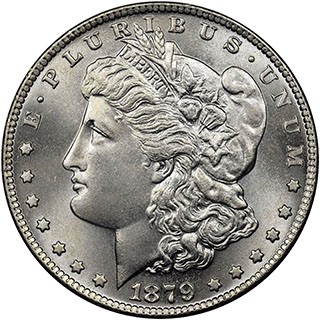 |
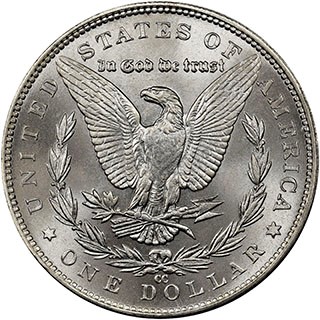 |
| Counterfeit 1879-CC Morgan Dollar Click images to enlarge. |
|
As you can see from the photos above, the coin submitted for grading appears to be essentially flawless. In fact, it almost has the look of a more-modern issue rather than a 141-year-old coin. This is because that’s exactly what it is. This is a very modern counterfeit that just has the “look” of a coin struck from dies almost certainly made using Computer Aided Design (CAD).
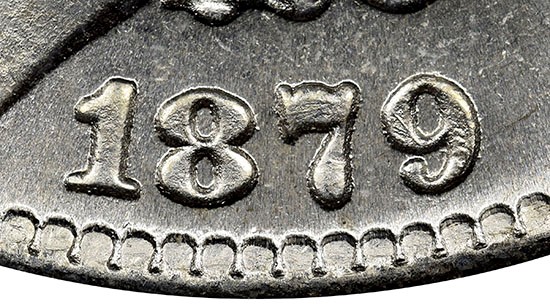 |
|
| Close-up of the date of the counterfeit
Click image to enlarge. |
|
The close-up photo above of the date shows two things. First, notice the die flow lines radiating towards the edge of the coin. This is a tell-tale sign that this coin was die-struck, which is actually a good sign. This metal flow is what creates the luster on die-struck coins.
Unfortunately, the photo also reveals many small lumps around the edges of the date, which are a very bad sign for authenticity. Additionally, the surfaces of the digits are more rounded than they should be. On genuine examples, the digits are much flatter, as they were struck using enough pressure to completely strike up.
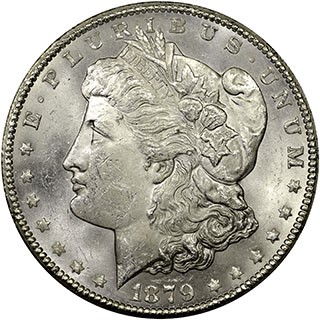 |
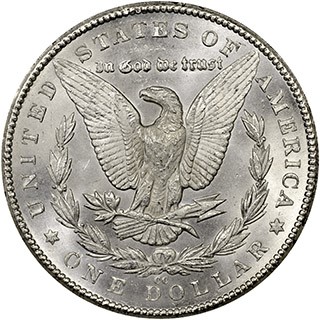 |
| Genuine 1879-CC Morgan Dollar Click images to enlarge. |
|
Compare the counterfeit to the genuine 1879-CC Morgan Dollar pictured above. As you can see, the genuine example has luster that looks very different from the counterfeit. However, when you look closer, the coins look even more different.
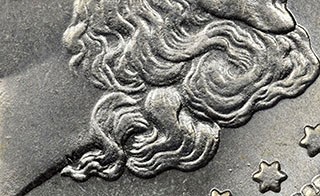 |
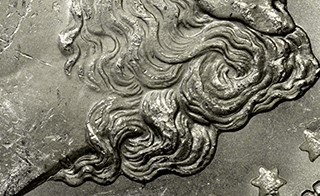 |
| Close-up images of the counterfeit (left) and genuine (right) 1879-CC Morgan Dollars Click images to enlarge. |
|
The photos above really show the difference between the two coins. Note the porosity of the counterfeit coin, especially within the hair. Additionally, there is significant detail loss in many areas where there was either detail lacking in the fake die or insufficient striking pressure to bring those details up.
Of course, it is always good to weigh any coin that is suspected to be a forgery. In this case, the coin weighed 26.75 grams, well within tolerances. However, the coin is noticeably thicker than a normal Morgan Dollar, which is explained by the fact that it is not silver but rather struck in an alloy of 65% copper, 24% zinc, 8% nickel, 2% manganese and only 1% silver.
This coin is a good example of the old saying “If it looks too good to be true, it probably is.” At first glance, this coin is simply too clean and mark free. However, from arm’s length, it would certainly fool many people, so it is important to carefully inspect any coin you may be purchasing. As always, NGC backs each graded coin with the comprehensive NGC Guarantee of grade and authenticity.
Did you know? NGC has created a comprehensive Counterfeit Detection resource to help collectors and dealers identify counterfeit and altered coins. Visit NGCcoin.com/counterfeit.
Stay Informed
Want news like this delivered to your inbox once a month? Subscribe to the free NGC eNewsletter today!
